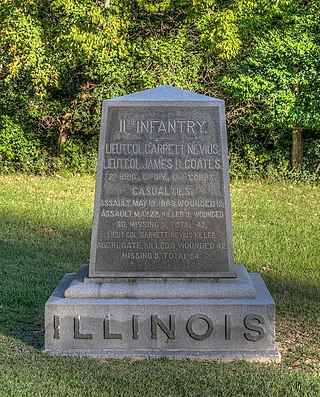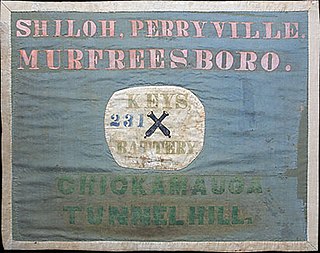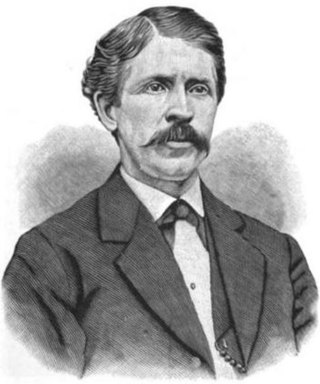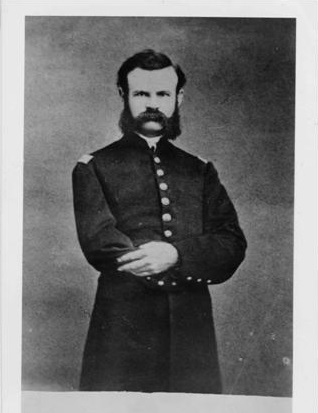The 8th Iowa Infantry Regiment was an infantry regiment that served in the Union Army during the American Civil War. It served mostly in the Western Theater with the Army of the Tennessee.

The 50th Regiment Illinois Volunteer Infantry, nicknamed the "Blind Half-Hundred," was an infantry regiment that served in the Union Army and fight with the Army of the Tennessee during the American Civil War. They engaged in such battles as Fort Donelson, Shiloh, Corinth, Vicksburg, the Atlanta Campaign, Allatoona, and the Marches to the Sea and north through the Carolinas.

Battery E, 1st Illinois Light Artillery Regiment was an artillery battery that served in the Union Army during the American Civil War. It played a minor but noteworthy role in the Battle of Shiloh, and was mentioned in General William T. Sherman's after-action report on the battle. It also served at Vicksburg, Brice's Crossroads, Nashville and in several other engagements in the Western Theater of the war.

The 114th Illinois Infantry Regiment was an infantry regiment from Illinois that served in the Union Army during the American Civil War. Formed in September 1862, the regiment served in Ulysses S. Grant's Central Mississippi campaign, in the Vicksburg campaign, at Brices Cross Roads, at Tupelo, in the 1864 Missouri campaign, at Nashville, and at Spanish Fort. At Nashville, the unit participated in the decisive attack on Shy's Hill. In 1865, the regiment was reassigned as pontoniers. The regiment was mustered out in August 1865.
The 72nd Ohio Infantry Regiment, sometimes 72nd Ohio Volunteer Infantry was an infantry regiment in the Union Army during the American Civil War.
The 77th Ohio Infantry Regiment, sometimes 77th Ohio Volunteer Infantry was an infantry regiment in the Union Army during the American Civil War.
Battery E, 2nd Illinois Light Artillery Regiment, was an artillery battery that served in the Union Army during the American Civil War.
Battery L, 2nd Illinois Light Artillery Regiment was an artillery battery that served in the Union Army during the American Civil War. It was also referred to as Bolton's Battery, Hulaniski's Battery, and Nichols' Battery. The battery fought at Shiloh, Corinth, Hatchie's Bridge, Port Gibson, Raymond, Jackson, Champion Hill, Vicksburg, and Yazoo City. The unit mustered out in August 1865.

6th Indiana Battery Light Artillery was an artillery battery that served in the Union Army during the American Civil War.
9th Indiana Battery Light Artillery was an artillery battery that served in the Union Army during the American Civil War.
Battery G, 1st Illinois Light Artillery Regiment, was an artillery battery that served in the Union Army during the American Civil War. The battery was also known as O'Leary's Battery and Rombauer's Battery.

The 11th Regiment Illinois Volunteer Infantry was an infantry regiment from Illinois that served in the Union Army during the American Civil War. In April 1861, it was formed as a three-month volunteer unit, and in July 1861 it was reorganized as a three-year unit, in which role it served until the end of the war. Two of its commanding officers were promoted to brigadier general and led major units during the war. In its first major action at Fort Donelson the regiment suffered terrible losses. The 11th Illinois also fought at Shiloh, Riggins Hill, Vicksburg, First Yazoo City, Second Yazoo City, and Fort Blakeley. In April 1863, the 109th Illinois Infantry Regiment was disbanded and its enlisted men transferred into the 11th Illinois. The regiment was mustered out of service in July 1865.
The 120th Illinois Volunteer Infantry was an infantry regiment in the Union Army during the American Civil War.

The Helena Artillery (1861–1865) was a Confederate Army artillery battery during the American Civil War. The unit was known by several other designations during the war including Clarkson's Battery, Company A, Shoup's Artillery Battalion, Calvert's Battery, and Key's Battery. The unit was occasionally assigned to artillery battalions from other states, so the Arkansas unit was at various times designated as Company C, 20th Alabama Light Artillery Battalion and later as Company H, 28th Georgia Artillery Battalion.
Battery C, 1st Missouri Light Artillery Regiment, also known as Mann's Independent Missouri Battery, was an artillery battery that served in the Union Army during the American Civil War. Organized between November 1861 and February 1862, Mann's Independent Battery fought at Shiloh and in the Corinth siege. After its name changed to Battery C, 1st Missouri in August 1862, it fought at Hatchie's Bridge, the Vicksburg campaign, the Meridian campaign, and the Atlanta campaign. In November 1864, the battery was assigned to the Nashville garrison; it remained there until it was mustered out in July 1865.

The Springfield Illinois Light Artillery, also known as Vaughn's Independent Illinois Battery or Battery A, 3rd Illinois Light Artillery, was an artillery battery from Illinois that served in the Union Army during the American Civil War. Organized in August 1862, the unit was first stationed at Bolivar, Tennessee. In August–September 1863 the battery participated in Frederick Steele's expedition to Little Rock, Arkansas, being engaged at Bayou Fourche. In spring 1864, the battery took part in the Camden Expedition, fighting at Prairie D'Ane and Jenkins' Ferry. The unit sat out the remainder of the war in Little Rock before being mustered out of service in June 1865.

Cogswell's Battery Illinois Light Artillery was an artillery battery from Illinois that served in the Union Army during the American Civil War. Organized in November 1861 as Company A, 53rd Illinois Infantry Regiment, it was detached as an independent artillery battery in March 1862. The battery participated in the Siege of Corinth in May 1862. The unit remained near Memphis, Tennessee until June 1863 when it was ordered to reinforce the Siege of Vicksburg. Cogswell's Battery took part in the Jackson Expedition, the Missionary Ridge and in the Knoxville campaign in 1863. After performing garrison duty for most of 1864, the unit fought at Nashville in December. In spring 1865, the battery fought at Spanish Fort and Fort Blakeley during operations against Mobile, Alabama. The battery was mustered out in August 1865.

Battery I, 1st Illinois Light Artillery Regiment was an artillery battery from Illinois that served in the Union Army during the American Civil War. The battery was organized in February 1862 at Chicago and within two months it fought at Shiloh. Later, the battery served at Corinth, Vicksburg, Jackson, Missionary Ridge, Knoxville, Franklin, and Nashville. The battery mustered out of Federal service in July 1865.

Battery K, 1st Illinois Light Artillery Regiment was an artillery battery from Illinois that served in the Union Army during the American Civil War. The battery was organized in January 1862 at Shawneetown and spent most of 1862–1863 on guard duty in western Kentucky. However, part of the battery participated in Grierson's Raid and the Siege of Port Hudson in 1863. The battery fought at Okolona, Tupelo, Spring Hill, and Franklin in 1864. The battery mustered out of Federal service in December 1864; new recruits and re-enlisted veterans transferred to Battery E, 1st Illinois Light Artillery Regiment.

Battery F, 2nd Illinois Light Artillery Regiment was an artillery battery from Illinois that served in the Union Army during the American Civil War. The battery was organized in December 1861 at Cape Girardeau, Missouri. The unit fought at Shiloh, First Corinth, and Second Corinth in 1862 and at Vicksburg and Jackson in 1863. The battery served in the Atlanta campaign and at Nashville in 1864. It was mustered out of federal service in July 1865. The battery's first commander was John Wesley Powell who later led an exploration of the Grand Canyon.













